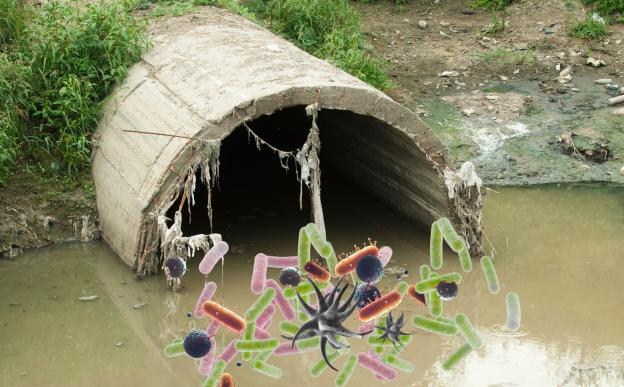
Image credit: Wikimedia Commons, Oregon State University
Plastic particles, a thousand times smaller than the thickness of our hair—the micro and nano plastics—have become a serious environmental hazard. In a recent study, a research team led by Prof T. I. Eldho of the Indian Institute of Technology, Bombay (IIT Bombay), in collaboration with Dr Anil Lonappan of the Mangosuthu University of Technology, South Africa, has devised a new technique to detect micro and nano plastic in laboratory samples without destroying the ambient nature of the samples. The technique uses the changes induced in the electrical properties of a material when placed inside a microwave cavity to identify the material. The researchers hope to develop handheld devices to detect the presence of pollutants in environmental samples. The study was published in the Journal of Hazardous Materials.
The challenges posed by plastic pollutants are well documented and have long since entered public debates. But in the last few years, studies have shed new light on another variety of plastic pollutants: nano and microplastics. Invisible to the naked eye and extremely small, these are found almost everywhere, from the pristine environments of the Antarctic to our internal organs. Studies have reported finding these tiny plastic fragments in crop plants, edible fruits, fishes, penguins and even human placenta. Additionally, they also appear to play a role in climate change. Researchers are still investigating the yet largely unknown environmental and health effects of micro and nano plastics. While emerging threats posed by micro and nano plastic pollutants are varied and significant, “a whole picture regarding the level of environmental contamination is unknown”, remarks Dr Renjith, who worked on the study during his postdoctoral research at IIT Bombay.
With awareness about micro and nanoplastics, there is a growing impetus to prevent and control their spread. One of the challenges in combating them, especially regarding questions of health, is that existing techniques to identify the presence of these tiny plastic pollutants are mostly laboratory-based, energy intensive and require expertise to operate. Thus, energy efficient, fast and economically feasible alternatives are highly desirable. In this context, the IIT Bombay team explored the possibility of using microwave radiation to detect plastic pollutants.
“Microwave processing requires less energy and time than other spectroscopic methods. Conventional methods may heat the sample from outside. As compared to such methods, the chances of sample degradation are less with microwaves”, explains Dr Renjith.
Microwave-based techniques are also generally considered to be environmentally friendly.
Microwave radiation interacts with various plastic polymers and alters some of its electrical properties. While low-frequency signals (upto 300 kHz) are used to study resistivity and conductivity, higher frequency signals(300 MHz to 4 GHz) are used to study dielectric parameters. In the current study, the researchers used microwave radiations in the S-band (2-4 GHz) and showed that the dielectric constant is useful in detecting plastics in both dry and wet samples. They also found two more properties, absorption loss and dielectric loss tangent, to be helpful in detecting plastics in dry samples.
Just as microwave radiation interacts with the water molecules in the food placed in a microwave oven and heats it up, microwave radiation also changes the electrical properties of materials when placed in a microwave cavity. Microwaves interact differently with different materials. The measurable changes that microwave radiation induces in the dielectric parameters for various materials are different. The changes are unique for each type of plastic. Thus, carefully measured variations in dielectric properties of a pollutant in a microwave cavity can be used to identify the presence of a pollutant in a given sample.
The setup devised by IIT Bombay researchers consists of a microwave cavity around a foot long and attached to a network analyser, an instrument which can measure various electrical parameters. The sample is placed inside the cavity using a very thin glass tube as a sample holder, and an appropriate high-frequency microwave is passed through the cavity. Using the network analyser, the researchers recorded the variations in the electrical parameters of the sample due to the presence of plastic polymers. This technique can currently identify some of the most abundant types of plastics found in the environment, namely polypropylene, low-density polyethylene, high-density polyethylene, and cross-linked polyethylene. Most of our daily-use plastic materials like bags, bottles, ropes, carpets, and computer components are made of these four plastic polymers.
While the technique proposed by the IIT Bombay team is efficient, economically viable and has given good results on laboratory-made samples, it is yet to be tested on real environmental samples.
“We have studied only four polymer types. In reality, there are other types of environmental plastic pollutants as well. Also, the sample size should be small, as the volume of the sample to cavity volume is very crucial,” Prof Eldho delineated the limitations of the study.
The limitation on the sample size means that the technique cannot be used to identify the polymer type in the case of large-sized plastic pollutants.
The group is currently trying to improve and expand the study by considering other frequencies of microwaves and more types of plastics seen in both environmental samples and biological materials. One of the major challenges they expect to face is in the design of the casing of the device and sample holder. The researchers plan to develop their technique into compact handheld devices that can be used widely to identify the presence of hazardous invisible plastic pollutants appearing almost everywhere.
“A major challenge is the design of the casing and sample holder. Our studies with the prototype of the test sample holder show that it is very sensitive to perturbations in the testing conditions,” Dr Renjith explains the challenges ahead.
The team is currently exploring options to address the issues with the sample holder and identify the best microwave frequency for real-world applications (to use in a device).
By employing microwaves for plastic detection for the first time, the researchers have opened up new avenues of application for microwaves and novel possibilities in identifying plastic pollutants. If this laboratory-based technique can be developed into handheld devices, as the researchers hope, it will go a long way in helping manage the threats posed by micro and nano plastics.
This article has been run past the researchers, whose work is covered, to ensure accuracy.

























